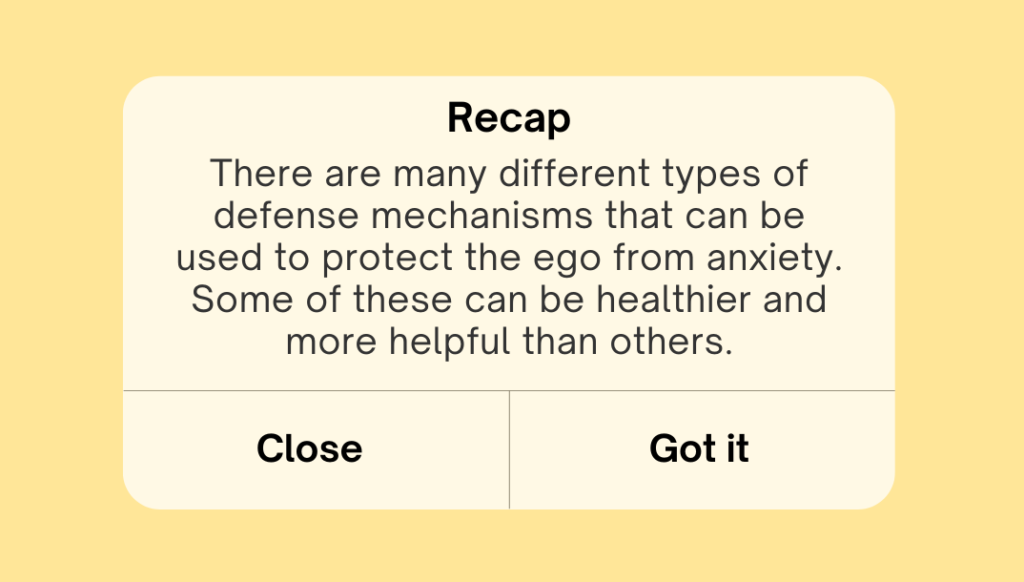This article discusses what defense mechanisms are and how they work. It also covers some of the different types of defense mechanisms and how these defenses are used.
:max_bytes(150000):strip_icc()/defense-mechanisms-2795960-5c4b8ad3c9e77c0001d7b94f.png)
10 Key Defense Mechanisms
Sigmund Freud’s daughter, Anna Freud, described 10 different defense mechanisms used by the ego. Other researchers have also described a wide variety of additional defense mechanisms.
Displacement
Have you ever had a really bad day at work and then gone home and taken out your frustration with family and friends? Then you have experienced the ego defense mechanism of displacement.
Displacement involves taking out our frustrations, feelings, and impulses on people or objects that are less threatening.
Displaced aggression is a common example of this defense mechanism. Rather than express your anger in ways that could lead to negative consequences (like arguing with your boss), you instead express your anger towards a person or object that poses no threat (such as your spouse, children, or pets).3
Denial
Denial is probably one of the best-known defense mechanisms, used often to describe situations in which people seem unable to face reality or admit an obvious truth (e.g., “He’s in denial”).
Denial is an outright refusal to admit or recognize that something has occurred or is currently occurring. People living with drug or alcohol addiction often deny that they have a problem, while victims of traumatic events may deny that the event ever occurred.
Denial functions to protect the ego from things with which the person cannot cope.
While it may temporarily shield you from anxiety or pain, denial also requires a substantial investment of energy. Because of this, other defenses are also used to keep these unacceptable feelings from conscious awareness.
In many cases, there might be overwhelming evidence that something is true, yet the person will continue to deny its existence or truth because it is too uncomfortable to face.
Denial can involve a flat-out rejection of the existence of a fact or reality. In other cases, it might involve admitting that something is true, but minimizing its importance. Sometimes people will accept reality and the seriousness of the fact, but they will deny their own responsibility and instead blame other people or other outside forces.

Repression and Suppression
Repression acts to keep information out of conscious awareness. However, these memories don’t just disappear; they continue to influence our behavior. For example, a person who has repressed memories of abuse suffered as a child may later have difficulty forming relationships.
Sometimes you might do this consciously by forcing the unwanted information out of your awareness, which is known as suppression. In most cases, however, this removal of anxiety-provoking memories from awareness is believed to occur unconsciously.
Sublimation
Sublimation is a defense mechanism that allows us to act out unacceptable impulses by converting these behaviors into a more acceptable form. For example, a person experiencing extreme anger might take up kick-boxing as a means of venting frustration.
Freud believed that sublimation was a sign of maturity that allows people to function normally in socially acceptable ways.
Projection
Projection is a defense mechanism that involves taking your own unacceptable qualities or feelings and ascribing them to other people. For example, if you have a strong dislike for someone, you might instead believe that they do not like you.
Projection works by allowing the expression of the desire or impulse, but in a way that the ego cannot recognize, therefore reducing anxiety.
Intellectualization
Intellectualization works to reduce anxiety by thinking about events in a cold, clinical way.
This defense mechanism allows us to avoid thinking about the stressful, emotional aspect of the situation and instead focus only on the intellectual component.
For example, a person who has just been diagnosed with a terminal illness might focus on learning everything about the disease in order to avoid distress and remain distant from the reality of the situation and their feelings about it.




